Abstract
OBJECTIVES: The purpose of this study was to determine whether county syphilis rates were increased along Interstate Highway 95 (I-95) in North Carolina during a recent epidemic. METHODS: Ecological data on syphilis cases demographic data, highway data, and drug activity data were used to conduct a cross-sectional and longitudinal study of North Carolina countries from 1985 to 1994. Crude and adjusted incidence rate ratios (IRRs) were determined by means of standard and longitudinal Poisson regression models adjusted for sociodemographic factors and drug use. RESULTS: Ten-year syphilis rates in I-95 counties greatly exceeded rates in non-I-95 counties (38 vs 16 cases per 100,000 persons) and remained higher after adjustment for race, age, sex, poverty, large cities, and drug activity (adjusted IRR = 2.05, 95% confidence interval [CI] = 1.84, 2.28). Syphilis rates were stable until 1989, when rates increased sharply in I-95 counties but remained stable in non-I-95 counties. Increased drug activity in I-95 counties preceded the rise in syphilis cases. CONCLUSIONS: A better understanding of the relationship between high-ways and the spread of sexually transmitted diseases may guide future prevention interventions.
Full text
PDF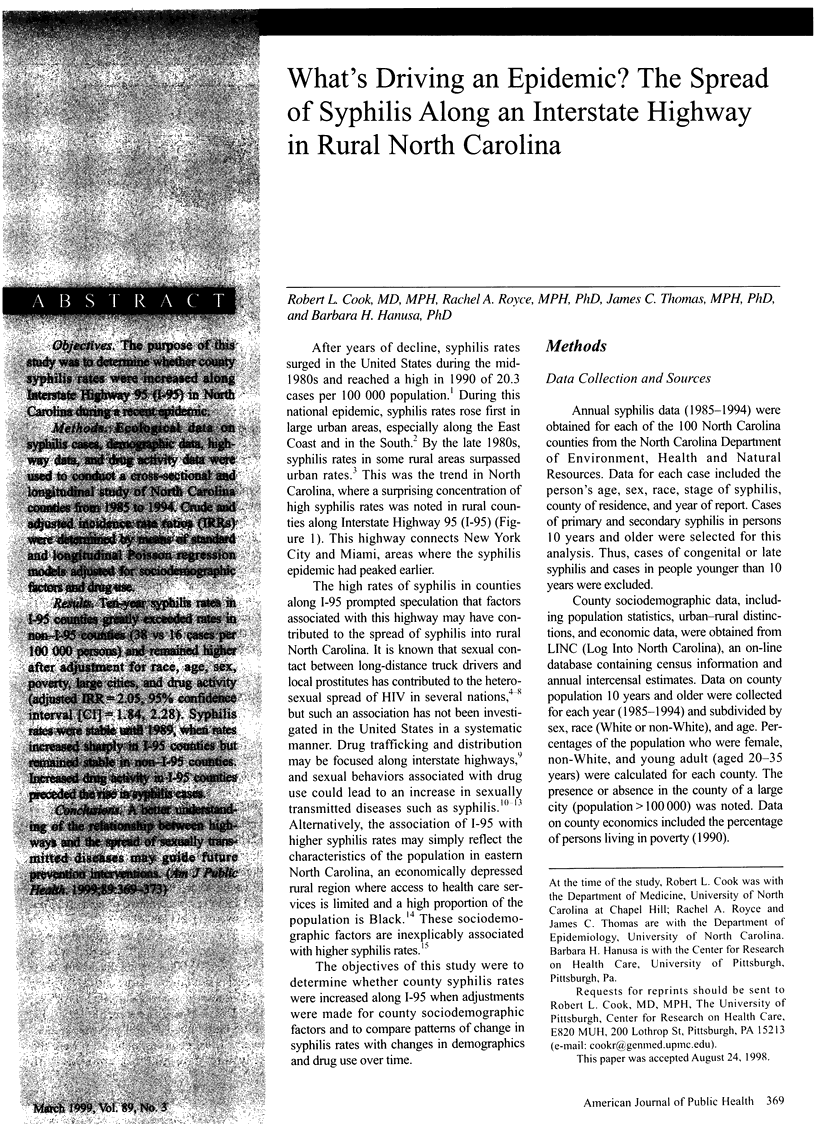
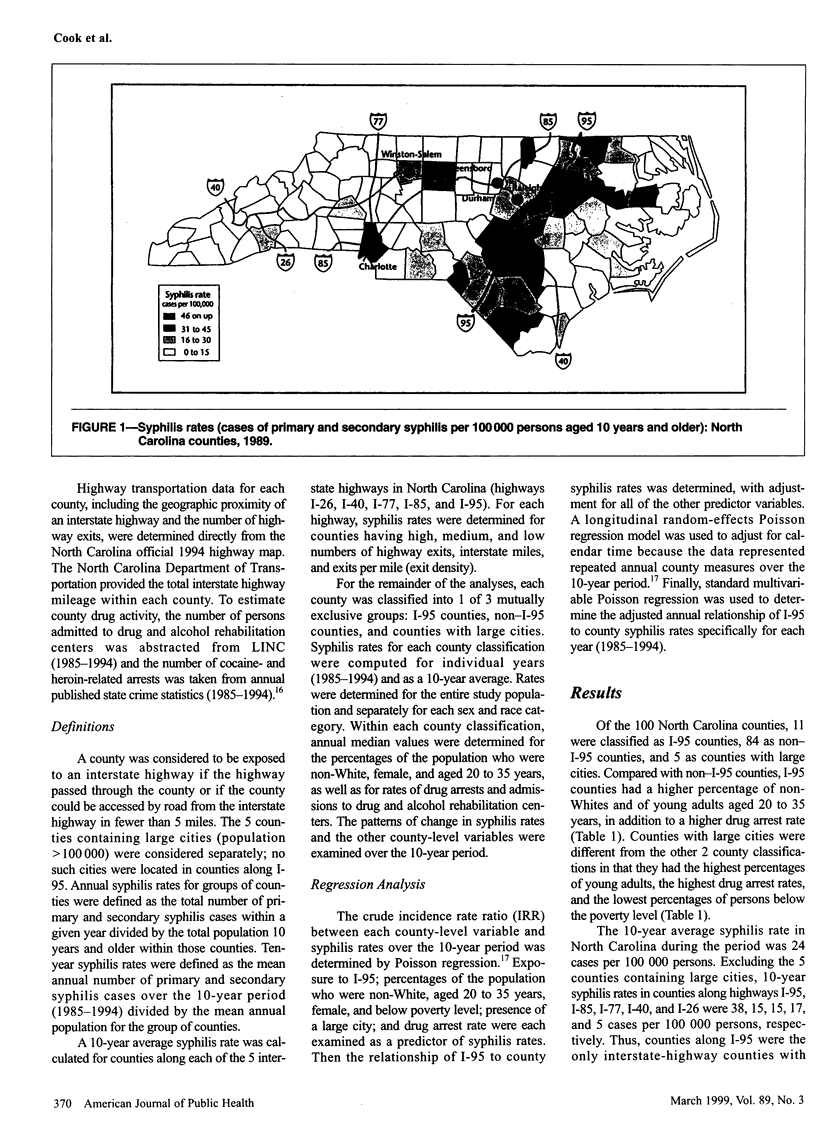
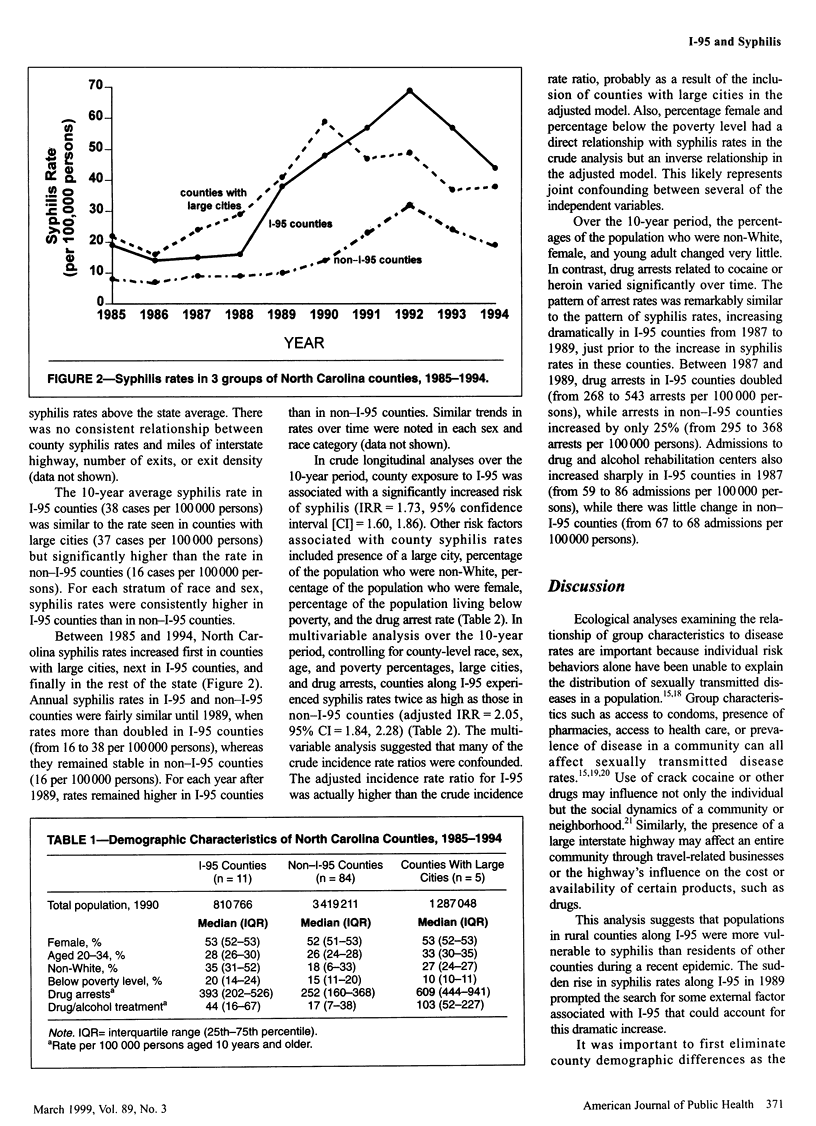
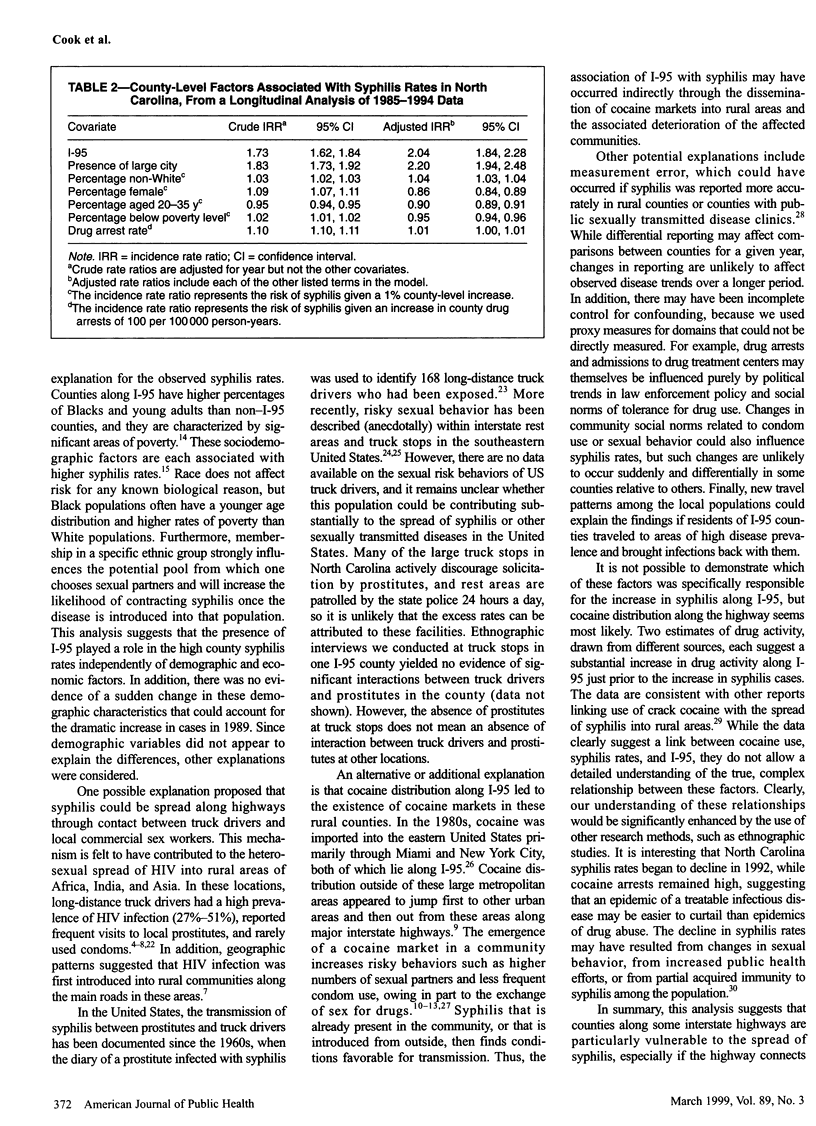
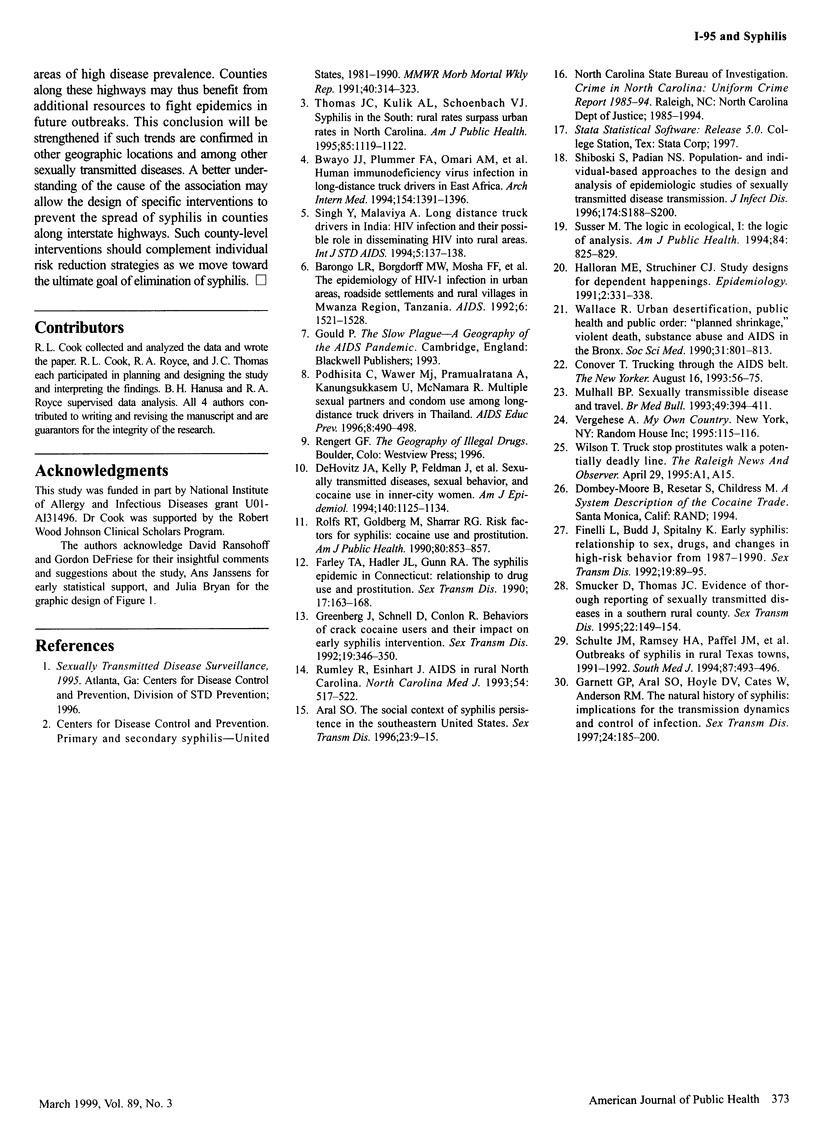
Selected References
These references are in PubMed. This may not be the complete list of references from this article.
- Aral S. O. The social context of syphilis persistence in the southeastern United States. Sex Transm Dis. 1996 Jan-Feb;23(1):9–15. doi: 10.1097/00007435-199601000-00005. [DOI] [PubMed] [Google Scholar]
- Barongo L. R., Borgdorff M. W., Mosha F. F., Nicoll A., Grosskurth H., Senkoro K. P., Newell J. N., Changalucha J., Klokke A. H., Killewo J. Z. The epidemiology of HIV-1 infection in urban areas, roadside settlements and rural villages in Mwanza Region, Tanzania. AIDS. 1992 Dec;6(12):1521–1528. doi: 10.1097/00002030-199212000-00016. [DOI] [PubMed] [Google Scholar]
- Bwayo J., Plummer F., Omari M., Mutere A., Moses S., Ndinya-Achola J., Velentgas P., Kreiss J. Human immunodeficiency virus infection in long-distance truck drivers in east Africa. Arch Intern Med. 1994 Jun 27;154(12):1391–1396. [PubMed] [Google Scholar]
- DeHovitz J. A., Kelly P., Feldman J., Sierra M. F., Clarke L., Bromberg J., Wan J. Y., Vermund S. H., Landesman S. Sexually transmitted diseases, sexual behavior, and cocaine use in inner-city women. Am J Epidemiol. 1994 Dec 15;140(12):1125–1134. doi: 10.1093/oxfordjournals.aje.a117212. [DOI] [PubMed] [Google Scholar]
- Farley T. A., Hadler J. L., Gunn R. A. The syphilis epidemic in Connecticut: relationship to drug use and prostitution. Sex Transm Dis. 1990 Oct-Dec;17(4):163–168. doi: 10.1097/00007435-199010000-00003. [DOI] [PubMed] [Google Scholar]
- Garnett G. P., Aral S. O., Hoyle D. V., Cates W., Jr, Anderson R. M. The natural history of syphilis. Implications for the transmission dynamics and control of infection. Sex Transm Dis. 1997 Apr;24(4):185–200. doi: 10.1097/00007435-199704000-00002. [DOI] [PubMed] [Google Scholar]
- Greenberg J., Schnell D., Conlon R. Behaviors of crack cocaine users and their impact on early syphilis intervention. Sex Transm Dis. 1992 Nov-Dec;19(6):346–350. [PubMed] [Google Scholar]
- Halloran M. E., Struchiner C. J. Study designs for dependent happenings. Epidemiology. 1991 Sep;2(5):331–338. doi: 10.1097/00001648-199109000-00004. [DOI] [PubMed] [Google Scholar]
- Mulhall B. P. Sexually transmissible diseases and travel. Br Med Bull. 1993 Apr;49(2):394–411. doi: 10.1093/oxfordjournals.bmb.a072617. [DOI] [PubMed] [Google Scholar]
- Podhisita C., Wawer M. J., Pramualratana A., Kanungsukkasem U., McNamara R. Multiple sexual partners and condom use among long-distance truck drivers in Thailand. AIDS Educ Prev. 1996 Dec;8(6):490–498. [PubMed] [Google Scholar]
- Rolfs R. T., Goldberg M., Sharrar R. G. Risk factors for syphilis: cocaine use and prostitution. Am J Public Health. 1990 Jul;80(7):853–857. doi: 10.2105/ajph.80.7.853. [DOI] [PMC free article] [PubMed] [Google Scholar]
- Rumley R. L., Esinhart J. D. AIDS in rural North Carolina. N C Med J. 1993 Oct;54(10):517–522. [PubMed] [Google Scholar]
- Schulte J. M., Ramsey H. A., Paffel J. M., Roberts M. A., Williams R. L., Blass C. M., Bell C. E., Simpson D. M. Outbreaks of syphilis in rural Texas towns, 1991-1992. South Med J. 1994 Apr;87(4):493–496. doi: 10.1097/00007611-199404000-00014. [DOI] [PubMed] [Google Scholar]
- Shiboski S., Padian N. S. Population- and individual-based approaches to the design and analysis of epidemiologic studies of sexually transmitted disease transmission. J Infect Dis. 1996 Oct;174 (Suppl 2):S188–S200. doi: 10.1093/infdis/174.supplement_2.s188. [DOI] [PubMed] [Google Scholar]
- Singh Y. N., Malaviya A. N. Long distance truck drivers in India: HIV infection and their possible role in disseminating HIV into rural areas. Int J STD AIDS. 1994 Mar-Apr;5(2):137–138. doi: 10.1177/095646249400500212. [DOI] [PubMed] [Google Scholar]
- Smucker D. R., Thomas J. C. Evidence of thorough reporting of sexually transmitted diseases in a southern rural county. Sex Transm Dis. 1995 May-Jun;22(3):149–154. doi: 10.1097/00007435-199505000-00003. [DOI] [PubMed] [Google Scholar]
- Susser M. The logic in ecological: I. The logic of analysis. Am J Public Health. 1994 May;84(5):825–829. doi: 10.2105/ajph.84.5.825. [DOI] [PMC free article] [PubMed] [Google Scholar]
- Thomas J. C., Kulik A. L., Schoenbach V. J. Syphilis in the South: rural rates surpass urban rates in North Carolina. Am J Public Health. 1995 Aug;85(8 Pt 1):1119–1122. doi: 10.2105/ajph.85.8_pt_1.1119. [DOI] [PMC free article] [PubMed] [Google Scholar]
- Wallace R. Urban desertification, public health and public order: 'planned shrinkage', violent death, substance abuse and AIDS in the Bronx. Soc Sci Med. 1990;31(7):801–813. doi: 10.1016/0277-9536(90)90175-r. [DOI] [PubMed] [Google Scholar]


